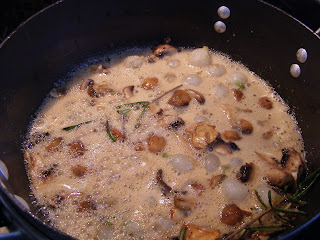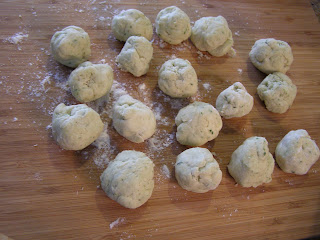I use skinless, bone-in chicken thighs. I am not a fan of chicken breasts in any preparation that is going to cook for any length of time, because the meat easily becomes dry and overcooked.
Just as with the beef braise, the chicken gets browned
in a little bit of fat
Here, I chose bacon fat because I had some on hand, and I wanted to add some of that smoky flavor to the braise, without adding bacon. You can achieve the same effect by rendering some bacon, and adding it right to the braise if you like. After the chicken is browned, it is removed from the pan, and quartered mushrooms and pearl onions are added to the fat to brown a little.
Here is the first significant departure from the beef braise -- I don't add garlic to this dish. Once the onions and mushrooms have browned a little, stir in a couple of tablespoons of flour and cook it with the fat for a few minutes. You can put it right on top of the vegetables -- no need to take them out of the pan.
The vegetable combination is the same here as in the
beef braise, minus the significant amount of garlic
After the flour has cooked for two or three minutes, nestle the chicken back in. Now for the second significant departure -- instead of red wine, I use a dark beer in this preparation. I like a porter for its smooth, caramel flavor and deep brown color, but any dark beer you like will do. If you don't like dark beer, then use a lighter colored beer, but be sure it has some body and flavor. No MGD 64 for this preparation.
no need for the beer to be flat --
all that carbonation will cook away during the braise
As you can see, I added a few sprigs of rosemary. I also added two cups of chicken stock. If you have home made, marvelous. If not, watch your sodium content in commercial broth, as the sauce will reduce quite a bit. At this point, I also added about a teaspoon of salt and freshly grated black pepper. You can continue to simmer this on top of the stove, but I prefer to put it, uncovered, in a 325 oven. Leave it there for about twenty minutes, while preparing the dumplings. This time, I made a dumpling similar to a recipe I saw in a Jamie Oliver book.
a food processor is a great way to make biscuit dough
One and a half cups of flour, a teaspoon and a half of baking powder, a teaspoon of salt and about a teaspoon of freshly grate nutmeg, and six tablespoons of cold butter go into the processor bowl (or you can combine them in a bowl and cut in the butter with a pastry cutter, a fork or your fingers.) I added a couple of tablespoons of chives because I still have them in the garden, but thyme, parsley, or tarragon would work just as well. After the butter is thoroughly cut into the flour, take about 3/4 cup of milk, buttermilk, or cream, and stream it into the dry ingrediants, using just enough to get a fairly stiff dough. Check for consistency as soon as the dough begins to form a ball.
the biscuit dough is rolled into ping pong-sized balls
Put the rolled dough back into the refrigerator for a few minutes to chill the butter. Take a look at your braise. It should be beginning to have some body in the sauce, and be a rich brown color.
the braise is beginning to color and thicken a bit --
now is the time to taste and adjust your salt and pepper
You don't want the sauce to cook down too much, because the dumplings will absorb quite a bit of liquid. If it has reduced too far, add some more chicken stock or a bit of water to loosen things up. That odd looking shape at the bottom of the picture above is a chunk of frozen chicken broth I added to thin things out a bit. I love the rich color of this braise. The dumplings are simply dotted around the top of the pot, and the whole thing is returned to the oven for 45 minutes, or until the dumplings are brown and crisp on top. You can speed the process a bit by upping the temperature of the oven to 375 or so.
the finished product -- simply serve one or two
of the chicken thighs along with some sauce, veggies, and dumplings
This is a rich and homey dish, but I did find it to be a bit filling. I think the next time I make it, I will go with a different style of dumpling, or maybe even serve it over noodles or spaetzle. The point is, once you understand the elements of a braise, and tastes that you enjoy together, you will be able to alter dishes with confidence, or to even create them from whatever you have on hand. It's a very useful skill to have, and certainly one worth practicing, so recipes will become an inspiration rather than a mandate.







No comments:
Post a Comment